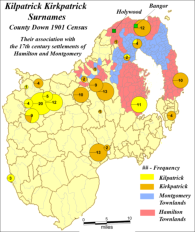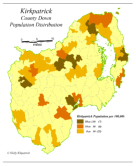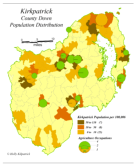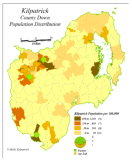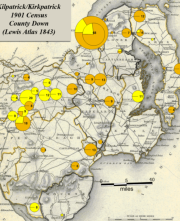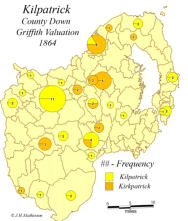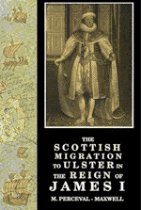



The Kilpatrick Surname Study


© Holly Kilpatrick

The Kilpatrick Surname Study
The Kilpatricks of County Down
According to the 1901 Census of County Down, there were 147 individuals with the surname Kilpatrick and 231 with the surname Kirkpatrick, making it the second most populous county for both surnames. Their distribution formed an axis stretching from Saintfield, through Dromore, to Banbridge. The Kirkpatricks were predominant in the eastern part of this cluster, whereas the Kilpatricks were concentrated in the western area. These individuals are likely to have migrated from the Ards Peninsula following settlement in the early 1600s.Intensity
When assessing intensity using the per 100,000 index, the geographic divide between Kirkpatricks and Kilpatricks becomes more apparent. Kirkpatricks seem to have prospered in several areas, whereas the Kilpatrick homeland appears to be concentrated near Dromore.Persistence
As previously mentioned, surname intensity requires time to develop. This aspect of surnames is further elucidated through the distribution of farmers in the 1901 census. Scottish land holdings transitioned to the feudal land tenure system, characterized by leases, a concept unfamiliar to native Gaelic farmers. Leases typically lasted for 30 years, with some extending to three generations. This effectively bound Scottish tenants to the land. In the 18th century, population pressure increased, leading to rent hikes and the transfer of leases to wealthier tenants. These pressures significantly contributed to 18th-century migration. In the 19th century, industrialization led to the displacement of farmers from their lands, which likely impacted the Kilpatricks, as evidenced by the presence of numerous agricultural laborers in their hinterland. Despite these changes, the hinterlands associated with the surnames generally remained cohesive.Historical Background
Large-scale migration to Ulster during the 17th century occurred primarily through the plantation process. However, it is often overlooked that Antrim and Down were not officially part of this plantation scheme. In contrast, the settlement of Down was initiated by Hugh Montgomery, a landowner with a significant estate near Braidstone in Northern Ayrshire, and James Hamilton, also hailing from Ayrshire. Although Hamilton was a less affluent Irish land agent, he held influential connections in the court of James I. In a plot rife with intrigue and drama reminiscent of a Shakespearean tale, they acquired substantial portions of Antrim and Down from Con O’Neill. This exchange occurred in return for O’Neill's escape from imprisonment in Carrickfergus, a feat facilitated by Montgomery. The Kilpatricks and Kirkpatricks played significant roles in the early settlement of County Down. The 17th century marked the beginning of colonization and settlement initiatives. James I had two primary objectives: to bring peace to the Borders and to control the adjacent "Irish frontier". These two policies were interconnected. The Borders, along with Scotland as a whole, had long been recognized as having an excess population. Colonization of Ulster was seen as a solution to these issues, and Hamilton and Montgomery eagerly took up the task. Both relied heavily on their tenants in Ayrshire, Dumfrieshire, and their surrounding areas. It is likely that both surnames, Kilpatrick and Kirkpatrick, were represented in the initial settlement of the region focused on the Ards Peninsula (Hollywood and Bangor, see map above), where both men had established their new settlements. They also drew extensively from adjacent Galloway, an area well- represented, particularly by the Kirkpatricks.
GeoGenealogy




